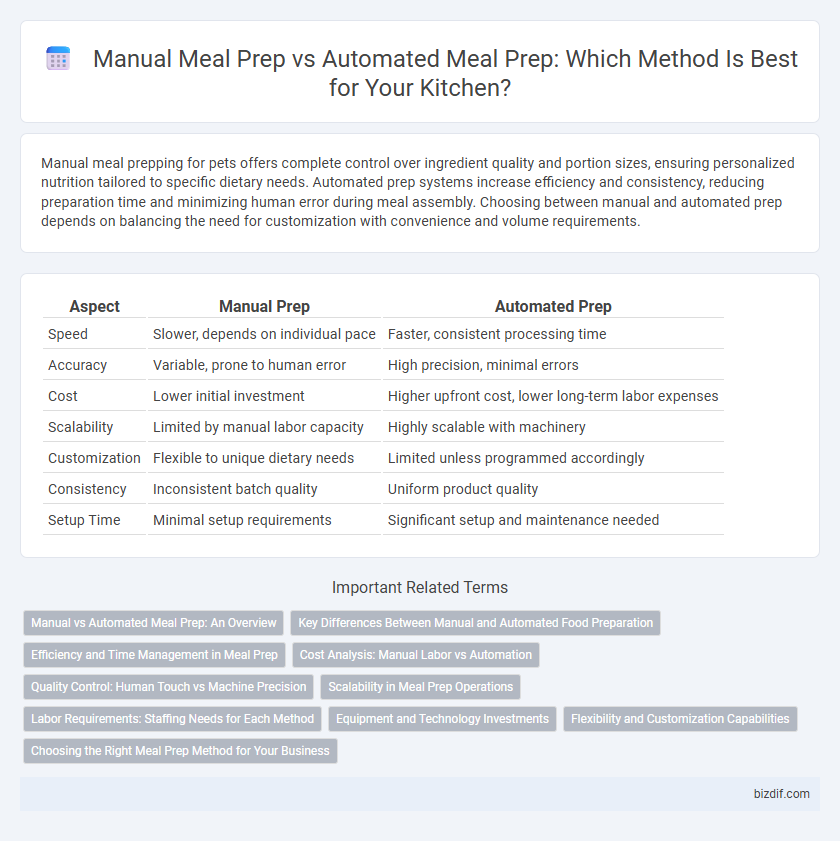Manual meal prepping for pets offers complete control over ingredient quality and portion sizes, ensuring personalized nutrition tailored to specific dietary needs. Automated prep systems increase efficiency and consistency, reducing preparation time and minimizing human error during meal assembly. Choosing between manual and automated prep depends on balancing the need for customization with convenience and volume requirements.
Table of Comparison
| Aspect | Manual Prep | Automated Prep |
|---|---|---|
| Speed | Slower, depends on individual pace | Faster, consistent processing time |
| Accuracy | Variable, prone to human error | High precision, minimal errors |
| Cost | Lower initial investment | Higher upfront cost, lower long-term labor expenses |
| Scalability | Limited by manual labor capacity | Highly scalable with machinery |
| Customization | Flexible to unique dietary needs | Limited unless programmed accordingly |
| Consistency | Inconsistent batch quality | Uniform product quality |
| Setup Time | Minimal setup requirements | Significant setup and maintenance needed |
Manual vs Automated Meal Prep: An Overview
Manual meal prep allows for complete control over ingredient selection and portion sizes, catering to specific dietary needs and personal preferences. Automated meal prep leverages technology to streamline cooking processes, increase efficiency, reduce preparation time, and minimize human error. Comparing manual and automated methods highlights trade-offs between customization, speed, and scalability in meal preparation strategies.
Key Differences Between Manual and Automated Food Preparation
Manual food preparation relies on human skill for cutting, mixing, and portioning, offering greater customization and control over ingredient selection and recipe adjustments. Automated food preparation utilizes machinery and technology to increase efficiency, consistency, and speed, minimizing human error in repetitive tasks. Key differences include labor intensity, production volume, precision, and scalability, with automated systems excelling in large-scale operations while manual prep suits small-batch or artisanal meals.
Efficiency and Time Management in Meal Prep
Manual meal prep allows for greater customization and control but often requires significantly more time and effort compared to automated meal prep systems, which streamline cutting, portioning, and cooking processes. Automated prep reduces repetitive tasks and minimizes human error, enhancing overall efficiency and supporting consistent meal portions, making it ideal for busy schedules. Investing in technology such as food processors, programmable cookers, and automated choppers can drastically improve time management and productivity in meal prep routines.
Cost Analysis: Manual Labor vs Automation
Manual meal prepping incurs higher labor costs due to hourly wages and longer preparation times, significantly impacting overall expenses for businesses and individuals. Automated meal prepping systems require substantial upfront investment in machinery and technology but reduce per-unit labor costs and boost efficiency over time. Analyzing the total cost of ownership reveals automation offers long-term savings despite initial capital expenditure, while manual prep remains more viable for low-volume or flexible meal preparation needs.
Quality Control: Human Touch vs Machine Precision
Manual meal prepping ensures meticulous quality control through human touch, allowing for customization, sensory evaluation, and immediate adjustments based on visual and taste cues. Automated meal prepping delivers machine precision, guaranteeing consistent portion sizes, standardized cooking times, and reduced human error, which enhances efficiency and scalability. Balancing human oversight with automation technology optimizes quality by combining intuitive judgment and exact replication.
Scalability in Meal Prep Operations
Manual meal prep limits scalability due to slower processing times and higher labor costs, making it challenging to meet increasing demand efficiently. Automated prep systems streamline workflows with consistent portioning and faster assembly speeds, enabling meal prep operations to scale effectively while maintaining quality control. Investing in automation technology enhances productivity and reduces errors, crucial for expanding meal prep businesses targeting larger customer bases.
Labor Requirements: Staffing Needs for Each Method
Manual meal prepping demands a higher number of staff members due to the time-intensive nature of chopping, cooking, and portioning each ingredient by hand. Automated meal prepping significantly reduces labor requirements by utilizing machines that handle repetitive tasks, allowing fewer employees to oversee operations and maintain efficiency. Staffing needs for automated methods focus more on technical skills for equipment maintenance rather than manual food preparation skills.
Equipment and Technology Investments
Manual meal prepping relies heavily on basic kitchen tools like knives, cutting boards, and storage containers, limiting efficiency but requiring minimal upfront investment. Automated meal prep integrates advanced equipment such as food processors, robotic cutters, and smart storage systems, significantly increasing productivity and consistency at a higher initial cost. Investing in technology like programmable timers and automated portion control machines optimizes workflow, reduces labor hours, and enhances scalability for commercial meal prepping operations.
Flexibility and Customization Capabilities
Manual meal prepping offers high flexibility and customization, allowing individuals to tailor ingredients, portion sizes, and recipes according to personal dietary needs and preferences. Automated meal prepping systems provide consistent portions and streamline repetitive tasks but may have limited adaptability for unique ingredient substitutions or specific dietary adjustments. Balancing manual and automated prep can optimize efficiency while maintaining the desired level of customization in meal planning.
Choosing the Right Meal Prep Method for Your Business
Choosing the right meal prep method for your business depends on factors such as volume, budget, and desired consistency. Manual prep offers flexibility and customization for small-scale operations, while automated prep enhances efficiency and scalability for larger enterprises. Evaluating labor costs, equipment investment, and production speed ensures optimal alignment with business goals and customer demand.
Manual prep vs Automated prep Infographic

 bizdif.com
bizdif.com